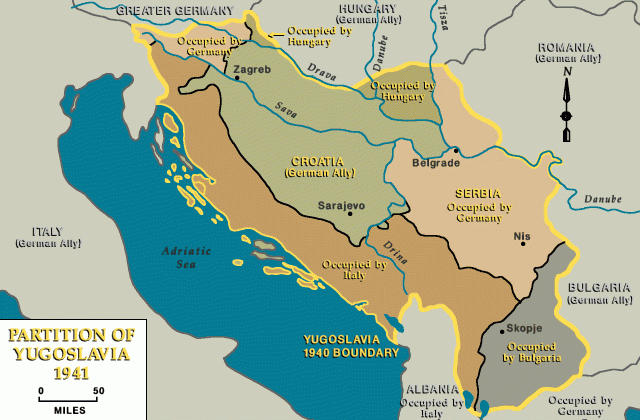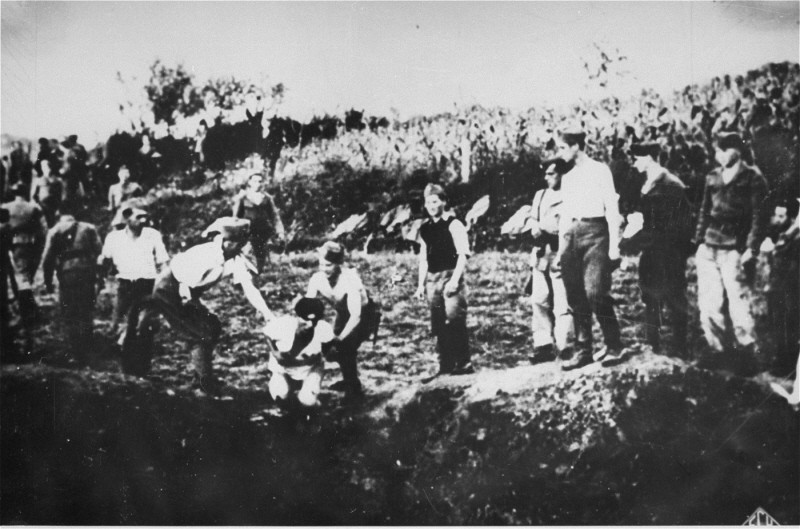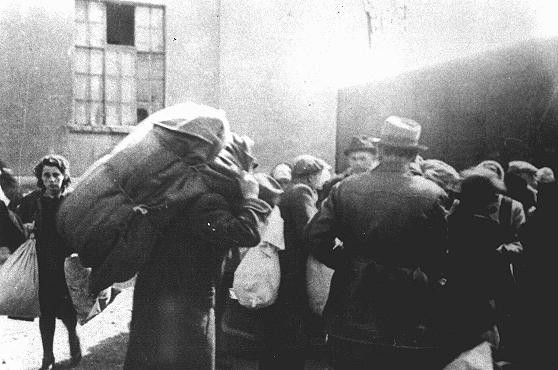
Axis Invasion of Yugoslavia
The Axis powers invaded Yugoslavia on April 6, 1941.
Invasion
On March 25, 1941, Yugoslavia joined the Axis and agreed to permit transit through its territory to German troops headed for Greece. The immediate reason for the Axis invasion of Yugoslavia was the Yugoslav government announcement that it would not honor its obligations under the agreement.
The debate over signing the Tripartite Pact that bound the Axis partners had bitterly divided the Yugoslav federal government. Prince Paul had pushed hard for it and had prevailed. The announcement of the agreement on March 25 was extremely unpopular in many parts of the country, particularly in Serbia and Montenegro. On March 27, Serb military officers overthrew the regency, placed the 17-year-old King Peter on the throne and denounced the previous government's decision to join the Axis. Although the new prime minister, Colonel Dusan Simovic, sought within days to retract this statement, Hitler was furious and ordered the invasion of Yugoslavia on the evening of March 27.
The Axis invasion, involving German, Italian, Hungarian, and Bulgarian military units, commenced on April 6, 1941. Eleven days later, after the Simovic government and King Peter fled to London via Alexandria, Egypt, Yugoslavia surrendered to the Axis powers.
Partition

The Axis powers partitioned Yugoslavia. They exploited ethnic tensions to reinforce new territorial boundaries.
- Germany annexed northern and eastern Slovenia, occupied the Serb Banat, which had a significant ethnic German minority, and established a military occupation administration in Serbia proper, based in Belgrade.
- Italy annexed southern and eastern Slovenia, occupied the Yugoslav coastline along the Adriatic Sea (including Montenegro) and attached Kosovo-Metohija to Albania, which Italy had annexed in April 1939.
- Under Ante Pavelic as Poglavnik (Leader), the Ustasa proclaimed an “Independent State of Croatia,” sponsored by Germany and Italy, which annexed Bosnia-Herzegovina. Despite the country's claim to be independent, Germany and Italy divided Croatia into zones of influence, in which each stationed troops.
- Hungary annexed the Backa and Baranja regions in northeastern Yugoslavia.
- Bulgaria occupied Macedonia and the tiny Serb province of Pirot.
Conflicts in the policy and tactics of Germany and its Axis partners impacted directly upon the fate of the Jews living in Yugoslavia.
Serbia
In April 1941, Germany established a military occupation administration in Serbia, and an indigenous administration and police force nominally supervised by a puppet Serb government under former Yugoslav general Milan Nedic.
German military and police authorities interned most Jews and Roma (Gypsies) in detention camps during the summer of 1941—Topovske Supe, Dedinje, Sabac, Nis, and, later, Semlin (Sajmiste), across the border in Croatia.
By the end of summer an uprising, based in Serbia and Bosnia and initiated by the Communist-led partisan movement and by the Serb nationalist Cetnik Movement of Draza Mihailovic, had inflicted serious casualties upon German military and police personnel. Hitler ordered that, for every German death (including those of ethnic Germans in Serbia and the Banat), German authorities were to shoot 100 hostages.
During the late summer and autumn of 1941, German military and police units used this order as a pretext to shoot virtually all male Serb Jews (approximately 8,000 persons), approximately 2,000 actual and perceived communists, Serb nationalists and democratic politicians of the interwar era, and approximately 1,000 male Roma. The German Security Police rounded up Jewish women and children and incarcerated them in the Semlin detention camp in the autumn of 1941. In the winter of 1942, the Reich Central Office for Security sent a gas van—a truck with a hermetically sealed compartment that served as a gas chamber—to Belgrade. Between March and May 1942, German Security Police personnel killed around 6,280 persons, virtually all Jews and mostly women and children from Semlin camp.
By the summer of 1942, virtually no Jews remained alive in Serbia, unless they had joined the partisans or were in hiding.
Croatia
In the so-called Independent State of Croatia, the Ustasa leadership instituted a reign of chaotic terror so extensive that German and Italian troops essentially had to administer the countryside. The Ustasa regime murdered or expelled hundreds of thousands of Serbs residing in its territory. In rural areas, Croatian military units and Ustasa militia burned down entire Serbian villages and killed the inhabitants, frequently torturing men and raping women. In all, Croat authorities killed between 320,000 and 340,000 ethnic Serbs in Croatia and Bosnia-Herzegovina between 1941 and 1942.

By the end of 1941, Croat authorities had incarcerated about two-thirds of the approximately 32,000 Jews of Croatia in camps throughout the country (Jadovno, Kruscica, Loborgrad, Djakovo, Tenje, Osijek, and Jasenovac. The Ustasa murdered between 12,000 and 20,000 Jews in the Jasenovac system of camps, located roughly 60 miles from the Croat capital, Zagreb. In two operations—August 1942 and May 1943—Croatian authorities transferred about 7,000 Jews into German custody. The Germans deported these Jews to Auschwitz-Birkenau. Approximately 3,000 Croat Jews evaded these deportations, largely because they were exempted from the deportations due to intermarriage or other reasons, or because they managed to flee to the Italian-occupied zone of Yugoslavia.
Generally rejecting or evading German demands to transfer Jews from these areas, Italian authorities instead assembled some of the Jewish refugees in a camp on the island of Rab off the Adriatic coast. Italian authorities removed a few hundred Jewish refugees in the Italian zone to refugee camps in southern Italy. After the Italian government surrendered to the Allies in September 1943, the rapid Allied occupation of southern Italy liberated these Jews. After the Italian surrender, the Germans occupied the Italian zone of Yugoslavia. Yugoslav Partisans liberated some 3,000 Jews from Rab before the Germans could occupy the island, and assisted them in avoiding capture.
Croat authorities also murdered virtually the entire Roma (Gypsy) population of Croatia and Bosnia-Herzegovina, at least 25,000 men, women and children, between 15,000 and 20,000 of them in the Jasenovac camp system.
Hungarian-Annexed, Bulgarian-Occupied Yugoslavia, and Kosovo-Metohija
In January 1942, Hungarian military units shot around 3,000 people (2,500 Serbs and 600 Jews) in northeastern city of Novi Sad, ostensibly in retaliation for an act of sabotage. Hungary, however, otherwise refused to deport Jews from the Backa and Baranja. After the Germans occupied Hungary in March 1944 and negotiated with the Hungarian authorities to remove the Hungarian Jews, Hungarian gendarmerie units concentrated the approximately 16,000 Jews of the Backa and Baranja in May 1944 in transit facilities—Backa-Topolya, Baja, and Bacsalmas. In early June, Hungarian gendarmerie units deported the Jews to the border of the Generalgouvernement and released them into the custody of German police, who transported them to Auschwitz-Birkenau, where the majority died in the gas chambers.

In Macedonia and the Serb province of Pirot, Bulgarian military and police officials concentrated virtually the entire Jewish population, more than 7,700 people, in a transit camp in Skopje in March 1943. Bulgarian authorities transported the Jews to the Serb border, where the Germans took custody of the transport and directed the train to the Treblinka killing center in German-occupied Poland. Virtually none of the Macedonian and Pirot Jews whom the Bulgarian authorities deported survived.
In Albanian-annexed Kosovo, which was under Italian rule, around 400 Jews, most of them native to the area but including refugees from Serbia, were incarcerated in Pristina. In the spring of 1944, the Germans deported between 300 and 400 to Bergen-Belsen, where between 200 and 300 died.
Collaboration in Yugoslavia
In addition to the puppet Nedic government in Serbia, which had both a gendarmerie and a political police department, the Germans relied on Albanian bureaucrats, Bulgarian military and police officials, Hungarian gendarmes, and the Croat government establishment along with the Ustasa militia to implement German policy in occupied and dismembered Yugoslavia. All were involved in the deportation and/or murder of Jews, Roma, Communists, and other political opponents in Yugoslavia. In combating the Communist-led partisans, the Germans and especially the Italians were able to count on some collaboration from Mihailovic's Cetniks, whose leaders, as it became clear that Germany would lose the war, sought to inflict damage on the Communists rather than the Axis.
German authorities recruited extensively for the Waffen SS among ethnic Germans in the Banat, the Backa, Baranja, and Croatia. In the Banat and Slovenia, ethnic Germans were subject to the German draft, though many volunteered for service in the Waffen SS or in the German SS and police forces in the Banat and Serbia. Some ethnic Germans were conscripted—in some cases involving the use of force. In the spring of 1943, the SS recruited among Bosnian Moslems for the proposed 13th Waffen SS Mountain Division Handžar, though the 13th Division could only be deployed in Bosnia between February and October 1944 due to the unreliability of the Muslim recruits operating outside their home base.
When German troops occupied Italy in September 1943, the SS and Police apparatus in Trieste had the task of rounding up and transporting Jews from northeastern Italy and Italian-annexed Slovenia to Auschwitz. To implement this operation, to which nearly 5,000 Jews fell victim, German SS and police authorities recruited and deploy police authorities, including some Slovenes recruited from Italian-occupied Slovenia.
German Withdrawal from Yugoslavia
When Romania withdrew from the Axis and joined the Allies on August 23, 1944, the German position in the Balkans became untenable. German troops evacuated Greece, Serbia, Albania, and Bosnia-Herzegovina in the autumn of 1944. German and Croat troops continued to fight in northwestern Yugoslavia until the end of April 1945 when they retreated to Austria along with the surviving leadership of the Ustasa regime.
The Germans and their Axis partners murdered more than 67,000 Jews on Yugoslav soil (including more than 3,500 Jews from other countries who had found refuge in Yugoslavia before the Axis invasion) between 1941 and 1945. Around 14,000 Jews survived, many by hiding with friends or neighbors or by joining the partisans. More than 4,500 Jews served in the partisan resistance movement; around 1,300 died in combat. Of the 14,000 survivors, more than half emigrated to Palestine (after 1948: Israel) after the war, leaving a Jewish population of around 6,500 in Yugoslavia by 1950.
The Germans and their Axis partners, especially the Croats, killed approximately 27,000 Roma in Yugoslavia. The Ustasa killed about 20,000 at the Jasenovac camp system and perhaps as many as 6,000 more on the Croatian and Bosnian countryside. German military and police authorities shot most of the remainder, between 1,000 and 2,000, in Serbia.
Postwar Justice
After the war, many of the leaders of the German occupation authorities in Serbia were extradited to Communist-led Yugoslavia to stand trial, including the Higher SS and Police Leader in Belgrade, August Meyszner. Nedic either committed suicide or was killed by Yugoslav authorities on February 4, 1946, after US authorities sent him back to Yugoslavia to testify as a witness against Nazi offenders.
Several of the Ustasa leaders, including Ante Pavelic and Andrija Artukovic, escaped via Austria and Italy to the New World. Pavelic lived in Argentina until an attempt on his life in 1957 induced him to relocate to the Spain of dictator Francisco Franco. Pavelic died in Spain in 1959. Artukovic entered the United States in 1946 under a false identity and was ordered deported in 1953. A US immigration court in Los Angeles, however, stayed the order of deportation on the grounds that Artukovic would face political discrimination as a Croat in Communist Yugoslavia. After changes in the US immigration law in 1978 eliminated Artukovic's eligibility for relief from deportation, the US Justice Department's Office of Special Investigations initiated new deportation proceedings in 1979. These proceedings were ongoing when Artukovic was extradited to Yugoslavia in 1986. Yugoslav authorities prosecuted and convicted him, sentencing him to death. Execution of the sentence was delayed, however, possibly with intent. Artukovic died in prison shortly thereafter of natural causes.
Yugoslavia after World War II
After World War II, the Yugoslav Union was reestablished under Communist rule, though the country's leaders broke with the Soviet bloc in 1948. In 1991–92, it dissolved again, this time as the result of an impending civil war that induced Slovenia and Croatia to declare their independence. In the vicious propaganda supporting the violence in Yugoslavia in the 1990s were numerous references to events in the former Yugoslavia during the Holocaust era.
Critical Thinking Questions
What pressures and motivations may have influenced ethnic groups in Yugoslavia to collaborate with the Germans or to pursue local Jews on their own?
How did Axis partners’ relationships affect the fate of the Jews of the area?

